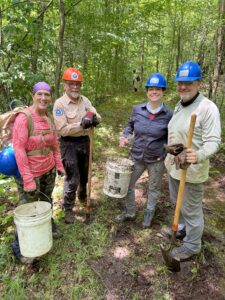Grand Staircase-Escalante National Monument (GSENM) is celebrating their 20th anniversary in 2016! Wilderness Volunteers has been working with Grand Staircase-Escalante for 18 of those years doing a variety of projects, from backcountry restoration to eradication of invasives to trail maintenance. One of the early highlights recalled by project leaders was Sage Sorenson playing a flute for participants in the Gulch during a lunch break.
Designated as a National Monument in 1996 by President Bill Clinton, the Grand Staircase-Escalante is the largest National Monument in the United States spanning nearly 1.9 million acres. It is managed by the Bureau of Land Management (BLM).
From its spectacular Grand Staircase of cliffs and terraces, across the rugged Kaiparowits Plateau, to the wonders of the Escalante River canyons, the Monument’s vast landscape offers unparalleled opportunities for scientists and visitors alike to experience the effects of millions of years of geological history. Reaching from the town of Escalante at the northeast end to Kanab in the southwest, the monument covers an area roughly the size of Delaware and was the last region in America to be explored.
Planned events include a 20th birthday party with cake and lemonade, an Open House, an Artists in Residence Veterans Salute, a art exhibition, the first annual Lower Calf Creek Falls hike, and a Science Forum covering topics such as Paleontology, Geology, Archaeology, Botany, Soils and Hydrology, and Recreation/Social Science.
Read more about events in the BLM’s event announcement.
 You can also celebrate GSENM’s 20th year with Wilderness Volunteers on our fall service project October 2-8th. Help remove invasive Russian Olive and Tamarisk from tributaries of the Escalante River and protect the beautiful and delicate riparian areas of the Grand Staircase-Escalante.
You can also celebrate GSENM’s 20th year with Wilderness Volunteers on our fall service project October 2-8th. Help remove invasive Russian Olive and Tamarisk from tributaries of the Escalante River and protect the beautiful and delicate riparian areas of the Grand Staircase-Escalante.
The non-native olive trees were originally planted to prevent erosion and stabilize soil but the trees have spread and in Utah they have colonized entire riverways, crowding out native vegetation, lowering the temperatures of the Escalante River, and making the riverway impassable to wildlife and hikers alike.
Project participants will likely car camp in a remote setting (or a designated campground close to the project area) and hike to the project site each day.
You can find out more about the project and apply to volunteer on it here.









